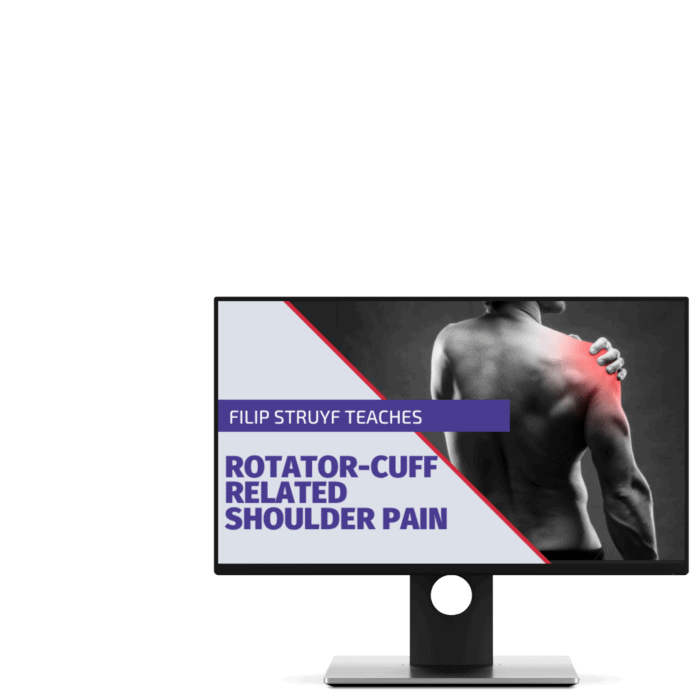Scapular Dyskinesis | Diagnosis & Treatment for Physios

Scapular Dyskinesis | Diagnosis & Treatment for Physios
Introduction & Epidemiology

Scapular dyskinesis (which may also be referred to as SICK scapula syndrome) is an alteration or deviation in the normal resting or active position of the scapula during shoulder movement. Sometimes, scapular dyskinesis is also referred to as SICK scapula, which is an acronym for Scapular malposition, Inferior medial border prominence, Coracoid pain and malposition, and dysKinesis of scapular movement. For most people, the scapula moves in abnormal ways due to repetitive use of the shoulder. For this reason, one might already be tempted to ask if scapular dyskinesis is a functional adaption or a pathological pattern we see in patients with shoulder pain.
According to McClure et al. (2011), the scapula displays the following movements including their average degrees of movement (including the standard deviation):

An important aspect when looking at the movement of the scapula is the scapulohumeral rhythm – or in other words – how much does the scapula move in relation to the humerus during arm elevation? Watch the following video in order to learn more about which movements in the shoulder girdle take place in a ‘healthy’ scapula according to the literature:
Seventy-seven percent of physiotherapists believe that a scapulohumeral ratio of 1:2 is normal. This is what we learn in school and what we display in our videos as well (Kirby et al. 2007). However, the 1:2 ratio was first described in 1944 in a single subject by Inman et al. (1996) and it got stuck! In reality, research shows that ratios vary considerably depending on gender, age, hand dominance, the plane of movement, bilateral or unilateral arm movement, speed of movement, different loads, different sports the patient is playing, fatigue, and pain.
So in fact, we really can’t reliably say what “normal” means!
In the following video you will learn about the function of different muscles acting on the scapula and classical ‘dysfunctions’ of the scapula described in the literature and their suspected underlying causes:
Be aware that there is a big prevalence of scapular dyskinesis in non-overhead athletes at 33% and even more in overhead athletes at 61% (Burn et al. 2016).
So in a lot of cases, scapular dyskinesis might be a functional adaption rather than a contributing factor to shoulder pathology!
On the other hand, Prezioso et al. (2018) did a cross-sectional study on 661 young asymptomatic elite swimmers and found a low prevalence of scapular dyskinesis of 8,5%.
Follow a course
- Learn from wherever, whenever, and at your own pace
- Interactive online courses from an award-winning team
- CEU/CPD accreditation in the Netherlands, Belgium, US & UK
Clinical Presentation & Examination
Examination
Kibler et al. (2002) were one of the pioneers in the classification of scapular dyskinesis. Up to today, the 4-type classification is the most commonly used method in scientific studies to determine if participants display scapular dyskinesis or not.
Watch the video if you want to learn more about the classification in detail:
In the following table, you can find an overview of the 4 different types and their clinical presentation according to Kibler et al. (2002).


Other orthopedic tests to assess scapular dyskinesis are:
LEARN TO DISTINGUISH SHOULDER FACTS FROM FICTION

Follow a course
- Learn from wherever, whenever, and at your own pace
- Interactive online courses from an award-winning team
- CEU/CPD accreditation in the Netherlands, Belgium, US & UK
Treatment
Should you focus on motor control training to improve scapular motion? McQuade et al. (2016) wrote a critical and theoretical perspective on scapular stabilization and summarize the following:
“Although some studies suggest that scapular stabilization exercises influence scapulothoracic (ST) muscle activation, it is not known whether increases in ST muscle activation or changes in activation ratios translate to any lasting kinematic pattern improvements. In total, there is little evidence to suggest that scapula motor control training can functionally affect scapula muscle activation. Learning to consciously control scapula position and using visual biofeedback appears to be good methods for immediately altering ST muscle activation or motion, yet the long-term clinical significance and transferability to daily functional tasks remain unknown.”
An RCT from Turgut et al. (2017) compared shoulder girdle strengthening+stretching exercises with strengthening+streching exercises plus the addition of scapular stabilization exercises. Although the stabilization group showed differences in external rotation, posterior tilt, and upward rotation, both groups showed improvement in self-reported pain and disability scores to the same degree. So while we might (Turgut et al. 2017) or might not (McQuade et al. 2016) be able to influence scapular kinematics, it seems that it might not be relevant for your shoulder patient’s outcome.
On top of that, Shire et al. (2017) did a systematic review and meta-analysis of six RCTs with four studies evaluating specific scapular exercise strategies and two with a specific proprioceptive strategy compared to general shoulder exercises. They state that no consistent difference was found between the treatment groups in these six studies regarding pain and function. Five of these studies were rated as moderate evidence and one as low-level evidence. For this reason, they conclude that there is insufficient evidence to support or refute the effectiveness of specific resistive exercise strategies in the rehabilitation of subacromial impingement syndrome.
In conclusion, our personal approach is to not focus too much on scapular kinematics, but rather on the strengthening of the rotator cuff and scapulothoracic musculature. You can find a graded exercise approach for scapular strengthening from early (post-operative) rehab to intermediate rehab:
Another exercise that targets the scapular muscles and at the same time strengthens the rotator cuff is the Y-lift:
Do you want to learn more about shoulder pain? Then check out our blog articles and research reviews:
- Why Shoulder Rehab should be like a Delicious Pizza
- Induce Pain to Relieve Pain in Rotator Cuff-Related Shoulder Pain?
- The Upper Traps – Over-Assessed, Overblamed, And Very Misunderstood!
- Conservative vs. Surgical Management of Patients with Rotator Cuff Tears
References
Follow a course
- Learn from wherever, whenever, and at your own pace
- Interactive online courses from an award-winning team
- CEU/CPD accreditation in the Netherlands, Belgium, US & UK
It’s Time to Stop Nonsense Treatments for Shoulder Pain and To Start Delivering Evidence-based Care


What customers have to say about this course
- Tineke De Vries26/01/25Goede cursus. Goede cursus, gericht op de praktijk Veel geleerd. Met name wat betreft de opbouw van de oefeningenDempsey Thiele02/01/25Overzichtelijk en praktisch! Ik heb de cursus met plezier afgemaakt. Ik denk dat dit een relevante cursus is voor iedere fysiotherapeut die meer inzicht wil krijgen over de huidige evidence omtrent schouder rehabilitatie. Alle informatie wordt overzichtelijk aangeboden.
Ik kan weer kritisch aan de slag mijn patiënten te helpen in de toekomst! - Carlijn Duursma27/12/24Goede cursus Veel verdieping. duidelijke uitleg. misschien wat tekeningen toevoegen voor extra verduidelijking. Veel geleerd.Vanessa Burnet22/12/24Leerzame cursus Opfrissing van kennis wat is weg gezakt.
- Paul Mensink15/12/24Paul Mensink High level literature composed course, videos are perfect examples for used techniques and exercisesFrank Kleyn12/12/24CRSP Ik kan bovengenoemde cursus zeer aanbevelen , nieuwste inzichten , zin en onzin van Subacromiale ruimte , de duidelijke vertaling naar de praktijk en de behandeltafel .
- Marty26/11/24RCRSP CURSUS Niet heel veel nieuws maar wel een goed overzicht en duidelijke uitleg over biomechanica.
Goede filmpjes van Filip en technieken ook goed uitgelegd.
Goede toetsen die de lesstof vrij compleet behandeld..
Website werkt naar mijn mening niet goed. Nogal onoverzichtelijk…
Vergt wat tijd om er mee om te gaan maar voordeel van de cursus is de gunstige prijs per accreditatie punt. Netjes.maria Kramer01/11/24goede cursus voor rcrsp Goede cursus met veel praktische vaardigheden en oefeningen die je direct kunt toepassen, aanrader. - Erik Versluis13/08/24Rotator Cuff Related Shoulder Pain RCRSP by Filip Struijf
State of the art course and very useful for physiotherapists with shoulder expertise or who want to further develop their skills in research and treatment of patients with shoulder complaints. A nice addition is a shoulder case in which you can process the knowledge you have recently acquired.
A major advantage is the possibility to read the course material offered and to watch the video material again.Birgit Schmitz28/04/24Rotator Cuff Related Shoulder Pain RCRSP
Ik vond het een waardevolle cursus met onderbouwd wetenscahppelijk onderzoek dat ondersteunt in mijn praktisch handelen. Ik heb al een nieuwe cursus uitgezocht. 🙂 - Thijs de Jager22/04/24Rotator Cuff Related Shoulder Pain GOEDE RCRSP CURSUS.
Over het algemeen een goede cursus waarbij ik veel ben opgestoken. Goede, evidence based informatie met hier een daar wat uitleg video’s die zeker helpvol waren. Het is ook fijn dat je onder de cursusonderdelen vragen kan stellen en hier een antwoord op kan verwachten van Filip zelf. 4 sterren i.p.v. 5 sterren omdat ik graag meer duidelijkheid en uitleg in video format over de oefeningen had willen zien. Er worden een hoop oefeningen getoond maar het is aan de cursist zelf om te bedenken welke in te zetten in de praktijk.Larson de Neve16/04/24Rotator Cuff Related Shoulder Pain GOOD COURSE
Good theoretical and practical course with exercises that you can immediately use in practice. - Beppeke Molenaar13/04/24Rotator Cuff Related Shoulder Pain OVERALL A GREAT COURSE
This is a very informative and comprehensive course.
Some of the quiz answers that are correct are counted as incorrect, which is a pity.
(Comment Physiotutors: We are currently doing an overhaul of our quizzing system and have fixed this issue now.)Willem Zee28/01/24Rotator Cuff Related Shoulder Pain PRIMA CURSUS!
goed te doen, uiterst praktisch - Jason Pearson11/01/24Rotator Cuff Related Shoulder Pain RCRSP COURSE
Very satisfied with this course. Provides a great framework with which to build your assessment and rehabilitation strategiesMichal Wajdeczko09/01/24Rotator Cuff Related Shoulder Pain Ik ben super blij ermee.
Het was een zeer interessante training. Het cursus was rijk met ge-update informatie, alles wordt volledig en transparant uitgelegd. Ik moet ook toevoegen dat deel van nuttige sets oefeningen briljant is! Veel nuttige tips en combinaties om rotator cuff pijn te kunnen verminderen en alle spieren efficiënt te trainen. Ik ben er trots op dat ik weer mijn kennis en competenties kon ontwikkelen en om mijn patiënten een professionele benadering van schoudercomplexe aandoeningen te kunnen bieden.
Super bedankt!! - Ante Houben30/12/23Rotator Cuff Related Shoulder Pain RCRSP
This course is well designed and based on solid evidence. The information is presented in a structured manner, using text, images and videos to enhance understanding. In addition, I appreciated the course’s emphasis on effectively conveying this information to patients. However, I wished the exercise therapy was more extensive.
Naomi Tiller20/12/23Rotator Cuff Related Shoulder Pain RCRSP COURSE
Fantastic course that’s easy to follow, up to date and evidence based. I’ve immediately been able to implement what I’ve learnt in to my own work which has given me a lot more confidence as well as made it more enjoyable! A good refreshed for me on how the rotator cuff works, a better understanding of how to treat these problems and better communicate with my patients as well as exercise inspiration (always appreciated!). Overall very happy to have done this course!
Super bedankt!! - Stijn de Loof17/12/23Rotator Cuff Related Shoulder Pain GOOD THEORY, LESS EXERCESIS
I liked the theoretical part of the course. A good refresher about the shoulder and rotator cuff with new insights
I was a bit disappointed in the part ‘exercises’. They were super basic and without explinations.Mehdi Benkirane24/11/23Rotator Cuff Related Shoulder Pain REVIEW
Très bon cours, je le recommande pour se remettre à jour sur les tendinopathies de l’épaule.




